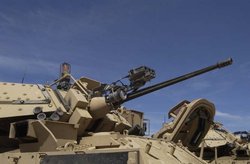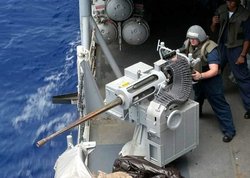M242
|
|
| ||
| Caliber: | 25 mm NATO | |
| Firearm action: | Chain gun | |
| Manufactured by: | ATK | |
| Barrel Length: | 85.6 in (2.175 m) | |
| Effective Range: | 1.2 miles (2 km) | |
| Maximum Range: | 4.23 miles (6,800 m) | |
| Maximum ROF: | 200 Rounds/Minute | |
| Muzzle velocity: | 3,609 ft/s (1,100 m/s) | |
| Total Weight: | 242.5 lb (110 kg) | |
The M242 Bushmaster is a 25 mm chain gun. It is currently used by the US Armed Forces and other NATO forces. It is used extensively on vehicles and aircraft.
It is an externally powered, chain driven, single-barrel weapon which may be fired in semi-automatic or automatic modes. It is fed by a metallic link belt and has dual-feed capability. The term "chain gun" derives from the use of a roller chain that drives the bolt back and forth.
It can destroy lightly armored vehicles and aerial targets (such as helicopters and slow-flying aircraft). It can also suppress enemy positions such as troops in the open, dug-in positions, and built-up areas. The standard rate of fire is 200 rounds per minute, and has a range of 2,000 meters (depending on the type of ammunition used).
The weapon was designed and originally manufactured by McDonnell Douglas (a subsidiary of the Boeing Corporation), however it is now produced by Alliant Techsystems (ATK) of Mesa, Arizona.
| Contents |
Design & History
Unlike most firearms, the M242 does not depend on recoil to actuate its firing system. Instead, it uses a 1.0 hp (750 W) DC motor, positioned in the receiver, to drive the chain and Dual-Feed system. The weapon assembly consists of three parts: the barrel assembly, the feeder assembly; and the receiver assembly. Due to the considerable weight of the system, the three-part structure makes installation or removal possible by a single person.
The weapon has received praise worldwide. To date, more than 10,000 pieces are in service. One of the major reason for this is the extremely reliable nature of the weapon. It has a rating of 24,000 Mean Rounds Between Stoppage (MRBS), much higher than many comparable devices.
Design on the weapon system was first begun in 1972 by McDonnell Douglas, however, the system was not put into service until 1981 when the M2 Bradley infantry fighting vehicle was first produced. Since 1990, there have been several enhancements made upon the weapon, resulting in the Enhanced 25 mm gun.
Dual-Feed System
A dual-feed system uses sprockets and extractor grooves to feed, load, fire, extract, and eject rounds. A system of clutches allows either sprocket to engage and feed either an AP or High Explosive cartridge with the flick of a switch.
Ammunition
A wide range of ammunition has been developed for this weapon, providing it with the capability to defeat the majority of armored vehicles it is likely to encounter, up to and including some tanks. The ammunition used in the M242 may also be used in a variety of weapons such as the French Giat M811, the GAU-12, or the Oerlikon KBA weapon system. It has the capability to fire U.S. manufactured ammunition as well as their NATO equivalents. Primarily though, it can fire six types of rounds: the M791, M792, M793, M910, MK210, and M919.
- M791 Armor Piercing Discarding Sabot with Tracer
- 5.7 million rounds produced
- The APDS-T penetrates lightly armored vehicles, Self-propelled artillery, and aerial targets such as helicopters and various slow-moving, fixed-wing aircraft.
- M792 High Explosive Incendiary with Tracer and Self Destruct
- 5.5 milion rounds produced
- The HEI-T can destroy unarmored vehicles and helicopters and suppress antitank missile positions and enemy squads out to a maximum effective range of 3,000 meters.
- M793 Target Practice with Tracer
- 11.5 milion rounds produced
- The TP-T cartridge is a fixed-type, percussion-primed training round that matches the High Explosive Incendiary with Tracer (HEI-T MK210) round ballistically. The TP-T's tracer is visible out to 2,000 meters, however, the round has a maximum effective range (accuracy-limited) of 1,600 meters.
- M910 Target Practice Discarding Sabot with Tracer
- The TPDS-T replicates the flight pattern of the M791 Armor Piercing Discarding Sabot with Tracer (APDS-T) round. The TPDS-T allows units to realistically practice sabot engagements.
- MK210 High Explosive Incendiary with Tracer
- 228,000 rounds produced
- Used by the U. S. Navy in their Mk38 naval weapon system.
- M919 Armor-Piercing, Fin-Stabilized Discarding Sabot With Tracer.
- The APFSDS-T round penetrates light armored vehicles, self-propelled artillery, and aerial targets, which includes helicopters and slow-moving fixed-wing aircraft. It is identical to the M791 Armor Piercing Discarding Sabot with Tracer except in its quality of being fin-stabilized.
Variations
The M242 is an extremely popular weapon. It is currently in use by the U.S. Army, the U. S. Navy, the U. S. Marine Corps, the Norwegian Army, the Swiss Army, the Canadian Army, the Finnish Army, the Australian Army, as well as several others. Such a wide usage requirement has necessitated several variations and modifications on the standard M242 weapon system.
Ground Vehicles
LAV25-1.jpg
The M242 is standard equipment on the U. S. Army M2 and M3 Bradley fighting vehicles. It is also in use on the Canadian LAV-25. Currently, Bushmaster II 30 mm Chain gun (a successor to the M242) is also in use on the Marine Corps' Advanced Amphibious Assault Vehicle (AAAV). The M242 is also a popular choice of equippage for Armoured fighting vehicles manufactured around the world.
Enhanced 25 mm gun
In 1990 it was realized that the M242 needed to be updated. In doing so, three major systems and seven minor systems were improved. The modifications began with introducing a chrome-lined barrel, an enhanced feeder, and an enhanced receiver. The weapon systems also received minor upgrades such as quick-detachable link covers, a larger breach assembly, a high efficiency muzzle brake, longer recoil, an integral round counter, an extended life firing pin & spring, and a triple-spring drive clutch. It was first put to use on the M2A3 Bradley, the third version of the M2 Infantry Fighting Vehicle.
Aircraft
While the M242 itself is not used on aircraft, the 25 mm cartridge is a major tool on the AC-130U and also on the AV-8 Harrier II (with its GAU-12 Cannon). The sister weapon of the M242, the M230 30 mm Chain gun is standard equipment on the AH-64 Apache attack helicopter.
Naval
In 1977 the U. S. Navy realized that it needed a replacement for the Oerlikon 20 mm Mark 16 gun. In 1986 their need was satisfied with the introduction of the Mk38 weapons system. A derivative of the M242 system, the Mk38 consists of the M242 Chain gun and the Mark 88 Machine gun mount. It provides ships with defensive and offensive gunfire capability for the engagement of a variety of surface targets. Designed primarily as a close-range defensive measure, it provides protection against patrol boats, floating mines, and various shore-based targets .
Operation
The M242 weapon system has both electrical and manual fire control and can be operated electrically or manually. In doing so, the gunner can choose from three rates of fire: (1) Single Shot Semi-Automatic. The gunner can shoot as fast as he can squeeze the trigger. (2) Low Rate Fully Automatic. The weapon fires 100 rounds a minute, plus or minus 25 rounds. (3) High Rate Fully Automatic. The weapon fires 200 rounds a minute, plus or minus 25 rounds.
See also
- List of artillery
- M230 30 mm automatic cannon
- Bushmaster II 30 mm Chain gun
- Bushmaster III 35/50 mm Chain gun
External links and sources
- Federation of American Scientists: M242 (http://www.fas.org/man/dod-101/sys/ac/equip/m242.htm)
- U. S. Army Field Manual 3-22.1
- Canadian-American Strategic Review: M242 (http://www.sfu.ca/casr/101-m242.htm)
- 25 mm/87 (1") Mark 38 Machine Gun System (http://www.warships1.com/Weapons/WNUS_25mm_mk38.htm)



